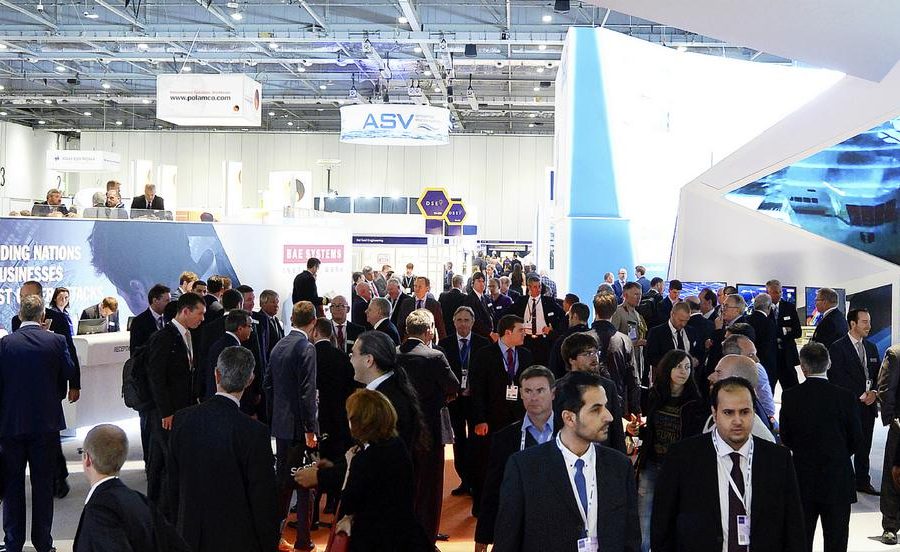
Military and industry leaders come together in London to discuss innovations in air, land and maritime defence.
Defence and Security Equipment International (DSEI) has announced the launch of its expanded DSEI Strategic Conferences that will feature five sessions covering policy, strategy and the implications on future equipment programmes.
Running on 11th September 2017 – Day Zero of the biennial event – at ExCeL London, senior military, government and industry officials from across the world will come together to hear sector leaders discuss air, land and maritime capabilities, as well as the future of military rotorcraft, trauma care and medicine.
Demonstrating the importance of global sharing of expertise, the DSEI Strategic Conferences will bring together international public and private sector professionals to discuss the future of defence and security capability.
Advancing Air Capability
Superiority in air defence is fast becoming a primary objective for military forces around the world and air support is playing an increasingly important role in a number of conflicts globally. Many nations are looking to expand their capabilities, but with governments looking to streamline defence budgets, air forces are now assessing ways in which they can acquire equipment via the secondary market, or how they can upgrade and extend the life of current platforms. The Gulf states of Qatar and Kuwait have taken this approach and are set to buy 36 Boeing F-15 fighter jets and 28 F/A- 18E/F Super Hornets, from the United States, in deals worth $3bn and $4bn respectively.
The Air Capability Conference, supported by the Royal Air Force, will explore the challenges of fleet modernisation, the future air battlespace and the secondary market. It will also assess the development and integration of fifth generation platforms to operate alongside third and fourth-generation equipment, including how the F-35 programme will operate alongside platforms such as the Typhoon.
Robotics and Artificial Intelligence (AI) in Land Warfare
Advances in automation, robotics and artificial intelligence are being recognised across the defence and security industry. The US Defence Department’s latest budget allocated $18bn to be spent over three years on a variety of technologies, including those needed for autonomous weapons. Meanwhile, the Pentagon is designing robotic fighter jets that would fly into combat alongside manned aircraft, has tested weapons that can decide what to attack and has built ships that can hunt for enemy submarines without human assistance.
The Land Capability Conference, led by the British Army, will welcome experts from around the world and leading figures from a range of industries to assess advances in sensors, robotics, computing and AI, and their future potential. The conference will also explore how developments in robotics and autonomous system (RAS) technology are being driven by non-traditional industry; presenting both opportunity and risk for many established sectors.
Impact of Maritime Collaboration
The critical importance of maritime trade and industry to the UK’s national prosperity is widely recognised. The UK government has stated that the National Shipbuilding Strategy is pivotal to its strategy to deliver a growing economy, and announced eight Royal Navy Type 26 frigates will be built on the Clyde at a cost of £8bn ($9.9bn) – safeguarding around 3,000 jobs.
Demonstrating the ways in which the Royal Navy and the Department for Transport (DfT) are setting the conditions for future maritime success, the Maritime Capability Conference has been designed specifically for those visiting DSEI and the concurrent London International Shipping Week event.
Future of Military Rotorcraft
Rotorcraft will remain vital to military and security operations for a long time to come. Whereas the market for civil helicopters has become soft, figures by analysts show an upward trend in the military market. Aircraft broker AvBuyer forecasts the $21.7bn global military rotorcraft market will reach $28.1bn by 2026.
As such, it is imperative that professionals examine how new military rotorcraft are being designed beyond traditional lines to increase their performance – particularly in range, speed and altitude. Responding to this growing market, the Future of Military Rotorcraft Conference, supported by Joint Helicopter Command, will look at aspects of rotorcraft design, including the integration of mission systems for deployment in a rapidly changing defence environment.
Trauma Innovation and Military Medicine (TIMM)
In times of conflict, military medicine and trauma care are forced to continually innovate and improve. However, when the intensity of conflict dissipates the level of innovation also drops. This requires the defence industry to think outside the box and establish what technologies and treatment modalities are available to break the mould of conventional thinking.
TIMM will bring together military and civilian healthcare professionals to discuss future equipment, facilities and capabilities to care for those who have been severely injured, whether that’s in a hospital or at the scene itself. It will also showcase the current research activity of military nurses and highlight how quality improvement initiatives are transforming care in the UK and overseas.
The programme will also host Triple Serpent, the UK Surgeon General’s biennial conference to which the NATO COMEDS and international Chief Medical Officers are invited.
Duncan Reid, Event Director at DSEI, commented: “Governments across the world often look beyond their own borders when sourcing defence equipment, training and expertise. Global alliances are key in sharing this information and cooperation between nations in some instances leads to a unilateral approach to national security.
“Britain leads the way in this respect, with Defence Secretary, Sir Michael Fallon, recently reaffirming Britain is committed to playing a leading role in global security at a meeting of European Union Defence Ministers in Brussels. DSEI’s expanded Strategic Conferences will bring together key stakeholders in the air, land and maritime sectors to innovate, share knowledge and showcase the latest equipment and systems industry has to offer.”
If you would like to join our community and read more articles like this then please click here








